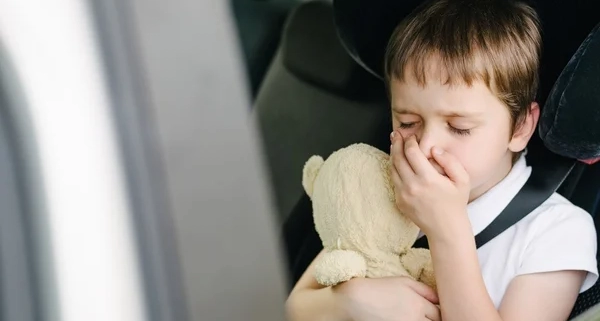Traveling for Memorial Day Weekend? Here’s What You Need To Know About Car Sickness
Life’s a journey, not a destination — even so, we want that journey to unfold as smoothly as possible, especially when we’re planning a holiday road trip. Memorial Day weekend kicks off the start of high season for population destinations like Rehoboth Beach, Cape May, Newport, and Nantucket.
Your child might have been a road warrior as an infant, but suddenly develop car sickness. According to a large 2019 study, car sickness is rare before age one, most common between four and 13, and most severe between six and nine. While motion sickness can affect anyone at any time in life, it’s less common after puberty — and can be prevented with the right strategies in place.
Why Does Car Sickness Happen?
Car sickness occurs when the inner ear and eyes receive mixed messages about motion. Normally, when a child looks out the window, all sensory signals tell the brain, “We’re moving forward!” Yet, when children are seated low in the backseat, buried on a tablet or in a book, the inner ear will say “we’re moving,” but the eyes will conflict with the message “no, we’re sitting still!” The sensory mismatch confuses the brain, triggering symptoms ranging from yawning, fatigue, dizziness, and headache, to cold sweats, mood changes, nausea, and vomiting.
How To Prevent Car Sickness
- Food: While it may be tempting to hit up the McDonald’s drive-thru, packing bland snacks like pretzels, dry cereal, bananas, cold lunch meats, peanut butter sandwiches, ginger biscuits, and apple slices are your best bet for travel. Sucking on ginger, peppermint, or Queasy Pops can help prevent nausea. Avoid sugary snacks and drinks.
- Airflow: Opening the windows or pointing cool-blowing air vents your child’s way is an ideal strategy for preventing car sickness or reducing its after-effects. Have your child take deep breaths in and slow breaths out to recalibrate.
- Focus: Encourage your child to look outside the car — through the front windshield, at the horizon, if possible. Look at a stationary object like a tree, mountain, or street sign. Be sure to remove hanging air fresheners or anything else that obstructs your child’s view. TVs mounted on the back headrests are preferable to TVs in the center of the vehicle, which blocks the view.
- Screen Time: Even when stationary, kids can develop cybersickness from screen time. The Mayo Clinic recommends getting up and walking around every 30 minutes, though this isn’t exactly feasible on a multi-hour trip. If you can’t skip screens altogether, try to have your child spend at least 20 seconds looking away from the screen — to an object at least 20 feet away — every 20 minutes.
- Activities: Reading and watching movies are two main culprits triggering car sickness. Of course, that’s precisely what your child will want to do on a long road trip! You might consider planning travel at a time when your child is more likely to sleep. Downloading audiobooks and family-friendly podcasts or the soundtrack to “Encanto” just might be fun enough to entertain the kids for a few hours on the road. You might play games like “I Spy,” Road Sign Bingo, 20 Questions, or “Would You Rather,” and keep track of the different brands and color vehicles you see. Gel window clings can be fun for kids to play with,
- Medication: Dramamine or Benadryl an hour before traveling can reduce the likelihood of travel sickness, though it may also make your child feel drowsy for up to 24 hours.
- Acupressure: More research is needed, but sea bands that apply pressure to the Pericardium 6 point can relieve nausea in some people.
- Support: Stress, worry, and memories of past car sicknesses can make matters worse. Try to keep a light-hearted approach with a “Oops, accidents happen!” Make sure your child feels loved and understands that it’s perfectly normal.
- Prepare: Proactively, you might bring a plastic pail with a garbage bag inside to catch any vomit or a hospital-grade barf bag. For younger children, a “vomit poncho” made from a towel, bib, or blanket might suffice.
- Clean Up: If your child becomes sick, clean up by removing as much vomit as possible, sprinkling the area with baking soda, and vacuuming with a Shop-Vac. Apply carpet cleaner, agitate with a brush, and dry with a towel, using an enzymatic cleaner to pick up any remaining odors.
- First Aid: If your child does become sick, it can help to stop the car, place a cool compress on your child’s head, and change position to either walk it off or lie down. Once the nausea passes, they can have small sips of cold water and a light snack.
Now you are better prepared to deal with whatever life throws you. We wish you happy travels! And if you decide to stay in the East End, stop by the Shine Studio for fun classes, workshops, and activities over the long Memorial weekend.



